
Wetenschap
Heliums huiveringwekkende reis om een deeltjesversneller te koelen
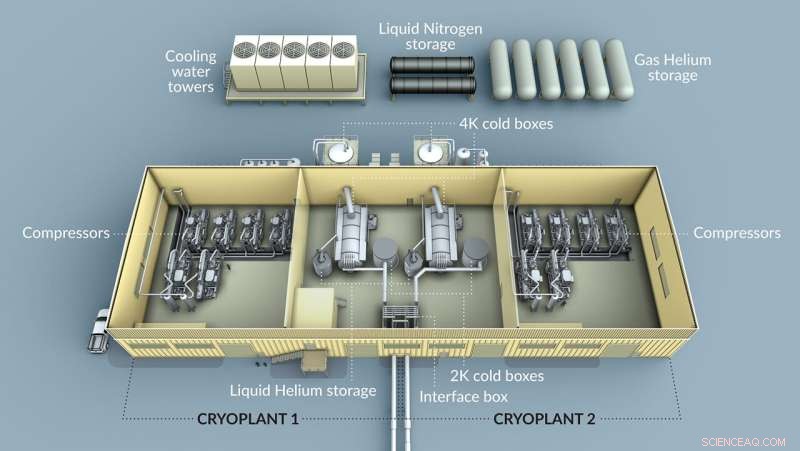
Een schema van de LCLS-II cryoplant. Credit:Greg Stewart/SLAC National Accelerator Laboratory
Tegenwoordig duurt het slechts anderhalf uur om een supergeleidende deeltjesversneller in het SLAC National Accelerator Laboratory van het Department of Energy kouder te maken dan de ruimte.
"Nu klik je op een knop en de machine gaat van 4,5 Kelvin naar 2 Kelvin", zegt Eric Fauve, directeur van het cryogene team bij SLAC.
Hoewel het proces nu volledig geautomatiseerd is, kostte het zes jaar ontwerpen, bouwen, installeren en opstarten van een ingewikkeld systeem om deze versneller, genaamd LCLS-II, tot 2 Kelvin of min 456 graden Fahrenheit te krijgen.
De originele LCLS, of Linac Coherent Light Source, versnelt elektronen om uiteindelijk röntgenstralen te produceren die worden gebruikt in atoom- en molecuulonderzoeksexperimenten. LCLS-II zal gelijktijdig met LCLS werken. In tegenstelling tot LCLS, dat bij kamertemperatuur koperen onderdelen gebruikt om elektronen te versnellen, maakt de LCLS-II-upgrade echter gebruik van supergeleidende cryomodules. Deze cryomodules geven elektronen efficiënter energie, wat zal helpen krachtigere röntgenpulsen te genereren om experimentele mogelijkheden over velden uit te breiden.
Maar terwijl LCLS bij kamertemperatuur kan werken, moet LCLS-II worden afgekoeld tot 2 Kelvin, slechts 4 graden Fahrenheit boven het absolute nulpunt, om supergeleidend te worden.
En dat betekende dat SLAC een team nodig had om zich te concentreren op koude dingen.
Een team samenstellen om een cryoplant samen te stellen
Voordat de LCLS-II afkoelde, was er bij SLAC geen groep gewijd aan cryogenics.
"Onze grootste uitdaging was dat dit de eerste keer was dat we dit met een nieuw team deden", zei Fauve.
Het LCLS-II Cryogenic-team, nu bestaande uit 20 operators en ingenieurs, is in 2016 bij SLAC gevormd om de faciliteit te bouwen die de versneller koelt:een cryogene fabriek.
"Dit is een gecompliceerd systeem met veel subsystemen die samenwerken", zegt Viswanath Ravindranath, hoofd cryogene procesingenieur voor LCLS-II.
SLAC werkte nauw samen met ingenieurs van DOE's Fermi National Accelerator Laboratory en Jefferson National Accelerator Facility, evenals met toonaangevende cryogene bedrijven om materialen voor de cryoplant te ontwerpen en aan te schaffen.
"Door deze samenwerking kon het LCLS-II-project profiteren van de beste cryogene bronnen binnen de DOE-laboratoria en elders", zei Fauve.
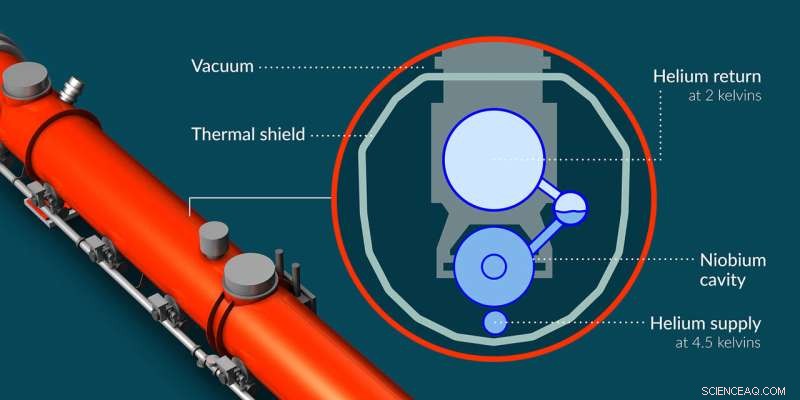
Een dwarsdoorsnede van de LCLS-II-versneller die laat zien waar vloeibaar en gasvormig helium in en uit het systeem stromen. Credit:Greg Stewart/SLAC National Accelerator Laboratory
De cryoplant wordt gevuld met helium, dat wordt gekoeld en vervolgens naar LCLS-II gepompt. Terwijl elk ander element onder de 4 Kelvin bevriest, kan helium vloeibaar blijven, en bij 2 Kelvin wordt helium supervloeibaar, wat betekent dat het zonder viscositeit stroomt. Dat feit, en het vermogen van supervloeibaar helium om warmte beter te geleiden dan welke andere bekende stof dan ook, maken het het perfecte koelmiddel om een supergeleidende versneller af te koelen.
Voordat de koeling begint, leveren trailers vol met hotdog-vormige tanks gasvormig helium op omgevingstemperatuur (ongeveer 300 Kelvin) aan de buitenopslagtanks van de cryoplant. De cryoplant heeft in totaal vier ton helium nodig.
Maar dit helium komt onzuiver aan. Eventuele onzuiverheden zullen uiteindelijk bevriezen en het systeem verstoppen, dus de eerste luchtreinigers moeten vocht of ongewenste gassen, zoals stikstof, opvangen om 99,999% helium te verkrijgen.
Na zuivering verhogen compressoren de druk van het helium. The pressure and temperature of a gas are coupled:as pressure decreases, temperature also decreases. So, while helpful later, this incidentally raises helium's temperature to 370 Kelvin.
Following compression, five large towers containing cooling water are used to lower helium's temperature back down to 300 Kelvin. The gas then enters the cryoplant's 4K cold box, which is a giant, uber-complicated helium refrigerator.
In the cold box, liquid nitrogen running 77 Kelvin knocks the helium down from 300 Kelvin to 80 Kelvin in a heat exchanger. In this device, the warm helium gas and colder liquid nitrogen travel in opposite directions while separated by a thin metal plate, transferring heat through the plate from the helium to the nitrogen. The plant uses 20 metric tons of liquid nitrogen every other day.
The helium then runs through a set of four turboexpanders. Now the initial gas-compressing step pays off:the turboexpanders expand the high-pressure gas, lowering its pressure enough to bring the helium all the way to 5.5 Kelvin.
However, the helium has more expanding to do before it can leave the cold box. It travels through a valve that has lower pressure on the other side. This lower pressure causes the gas to expand, lowering its pressure and bringing its temperature down to 4.5 Kelvin (hence the name of the 4K cold box), where it becomes a liquid.
This liquid helium is then sent through pipes to the accelerator's cryomodules, where it cools the machine to 4.5 Kelvin.
Once the 4K cold box was up and running, it took the Cryogenic team one week to cool LCLS-II from room temperature to 4.5 Kelvin, which it reached for the first time on March 28, 2022. But that's not cold enough!
Colder still
To reach 2 Kelvin, the 4.5 Kelvin helium undergoes yet another (final) expansion through a valve in the accelerator's cryomodules. Again, the lower pressure on the other side of the valve causes helium's pressure to drop. This cools helium to the goal temperature of 2 Kelvin.
Creating the low pressure inside the cryomodule is a feat in itself.
"The magic happens when it goes through that valve, but only because we have a train of cold compressors that maintains the pressure in the cryomodule at very low pressure," Fauve said. This set of five compressors stationed after the valve create the pivotal pressure difference on either side of the valve.
After months of turning on and configuring this cooling system, LCLS-II finally reached 2 Kelvin on April 15.
"Everything was possible because of all the hard work over the years from so many smart and dedicated people," said Swapnil Shrishrimal, cryogenic process and controls engineer for LCLS-II. "Being a small team, as well as a young team, we are very proud of the system we commissioned."
When the electron beam is on and being accelerated by the cryomodules, the 2 Kelvin helium will absorb heat from the accelerator, boil, and turn back into gas. That gas is injected back into the 4K cold box to help cool warmer helium.
"We don't want to waste the cooling capacity, so we try to recover as much of it as possible," Ravindranath said. The system recycles the helium, which is expensive, although essential for long-term operation.
The Cryogenic team actually built two cryoplants, which share a building, but LCLS-II only uses one. The second cryoplant will support planned upgrades to LCLS-II. When both cryoplants are on they will use approximately 10 megawatts of electrical power.
Only four other cryoplants in the United States cool this much helium to 2 Kelvin. Thomas Jefferson National Accelerator Facility and Fermi National Accelerator Laboratory, which both house cryoplants of similar magnitude, supported SLAC's design and procurement of equipment. SLAC collaborated with Oak Ridge National Laboratory, Brookhaven National Laboratory, and CERN as well.
"The years of expertise and support of our partner labs allowed us to do this," Shrishrimal said. Fauve also credits the team's success to their extensive planning and dedication. The entire Cryogenic team stayed on site during the pandemic to continue bringing the plant to life.
"Even when SLAC was shut down, if you were at the cryoplant you would not be able to tell the difference before and during COVID," Fauve said, except for the masks and social distancing, of course.
LCLS-II is expected to produce its first X-rays early next year. The Cryogenic team feels confident they will continue to run their very complicated refrigerator with ease.
"It's a pretty nice and easy operation now because everything is automated," Shrishrimal said. + Verder verkennen
Superconducting X-ray laser reaches operating temperature colder than outer space
 Sneeuwonderzoek vult hiaat in inzicht in Arctisch klimaat
Sneeuwonderzoek vult hiaat in inzicht in Arctisch klimaat De natuurlijke aerosolfabriek in de Himalaya kan het klimaat beïnvloeden
De natuurlijke aerosolfabriek in de Himalaya kan het klimaat beïnvloeden Inventarisatie lokaliseert de meest klimaatgevoelige Afrikaanse bossen
Inventarisatie lokaliseert de meest klimaatgevoelige Afrikaanse bossen Gevaarlijke klimaatverandering is waarschijnlijk, concludeert nieuw onderzoek
Gevaarlijke klimaatverandering is waarschijnlijk, concludeert nieuw onderzoek CryoSat onthult verrassende eb en vloed van subglaciale meren
CryoSat onthult verrassende eb en vloed van subglaciale meren
Hoofdlijnen
- Zoogdierhersenen identificeren type geur sneller dan ooit werd gedacht
- Het verschil tussen craniologie en frenologie
- De nacht zit vol met dieren, maar wetenschappers weten er heel weinig van
- Volledige structuur van mitochondriaal respiratoir supercomplex gedecodeerd
- Welke mechanismen zorgen voor de nauwkeurigheid van DNA-replicatie?
- Zouden herten aanwijzingen kunnen bevatten over het verband tussen malariaresistentie en sikkelcel?
- Waarom wordt magnesiumchloride gebruikt in PCR?
- Moderne celtheorie
- Hoe een TAPPI-kaart te gebruiken
- Onderzoekers ontwikkelen breedband röntgenbron die nodig is voor nieuwe metingen bij NIF
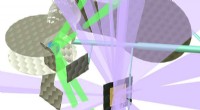
- Innovatieve methode biedt een nieuwe manier om de ontwikkelingsbiomechanica van het hart te bestuderen, woon in 4-D
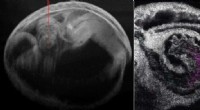
- Een openbare database van macromoleculaire diffractie-experimenten
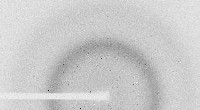
- GitHub-archiefopslag begraven tot de laatste 1, 000 jaar

- Laserpulsen maken de weg vrij voor het afstemmen van topologische materialen voor spintronica en kwantumcomputers
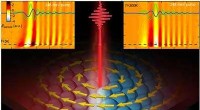
 Definitie van Desert Scrub
Definitie van Desert Scrub Onderzoekers brengen grafeen-elektronenwolken in beeld, onthullen hoe plooien de geleidbaarheid kunnen schaden
Onderzoekers brengen grafeen-elektronenwolken in beeld, onthullen hoe plooien de geleidbaarheid kunnen schaden Hoe tijd te berekenen Math
Hoe tijd te berekenen Math Geconstrueerde structuren die de lichtsnelheid kunnen veranderen, kunnen voordelen opleveren voor optische communicatiesystemen
Geconstrueerde structuren die de lichtsnelheid kunnen veranderen, kunnen voordelen opleveren voor optische communicatiesystemen Zweedse start-up haalt geld binnen voor batterij gigafactory
Zweedse start-up haalt geld binnen voor batterij gigafactory Het onderzoek naar coatings heeft tot doel het ijsvrij maken van vliegtuigen te verbeteren
Het onderzoek naar coatings heeft tot doel het ijsvrij maken van vliegtuigen te verbeteren Bodems kunnen worden beïnvloed door klimaatverandering, invloed op water en voedsel
Bodems kunnen worden beïnvloed door klimaatverandering, invloed op water en voedsel Team ontwikkelt nieuwe halfgeleiderverwerkingstechnologie
Team ontwikkelt nieuwe halfgeleiderverwerkingstechnologie
- Elektronica
- Biologie
- Zonsverduistering
- Wiskunde
- French | Italian | Spanish | Portuguese | Swedish | German | Dutch | Danish | Norway |

-
Wetenschap © https://nl.scienceaq.com

